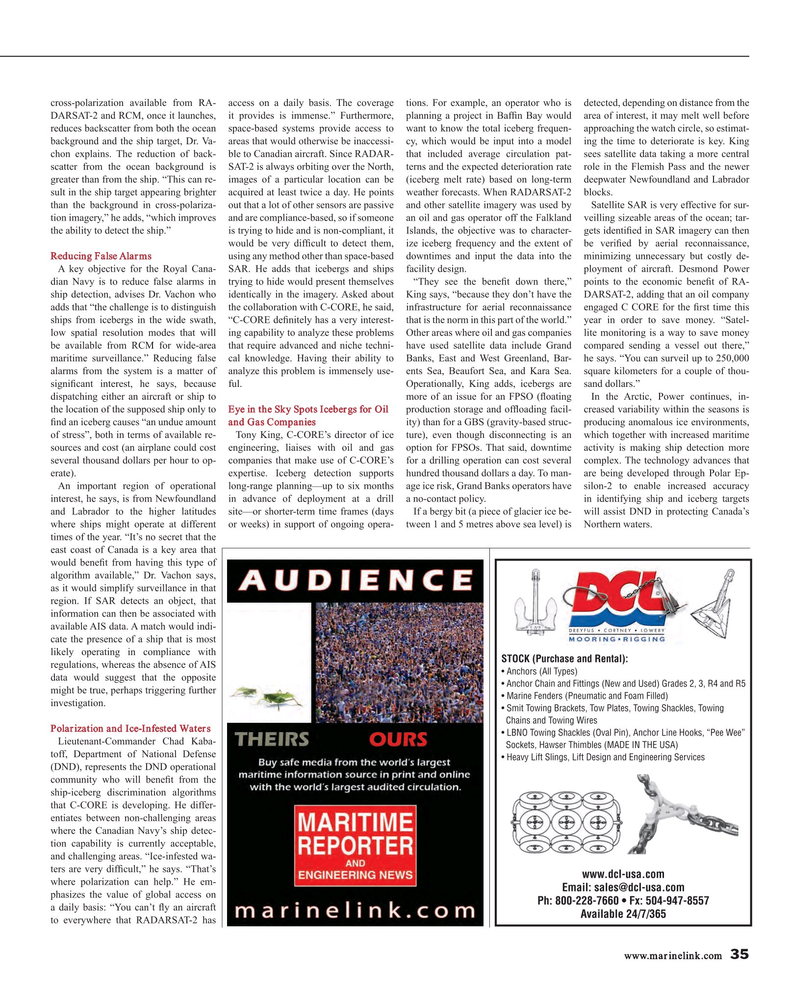
Page 35: of Maritime Reporter Magazine (July 2016)
Marine Communications Edition
Read this page in Pdf, Flash or Html5 edition of July 2016 Maritime Reporter Magazine
cross-polarization available from RA- access on a daily basis. The coverage tions. For example, an operator who is detected, depending on distance from the
DARSAT-2 and RCM, once it launches, it provides is immense.” Furthermore, planning a project in Baf? n Bay would area of interest, it may melt well before reduces backscatter from both the ocean space-based systems provide access to want to know the total iceberg frequen- approaching the watch circle, so estimat- background and the ship target, Dr. Va- areas that would otherwise be inaccessi- cy, which would be input into a model ing the time to deteriorate is key. King chon explains. The reduction of back- ble to Canadian aircraft. Since RADAR- that included average circulation pat- sees satellite data taking a more central scatter from the ocean background is SAT-2 is always orbiting over the North, terns and the expected deterioration rate role in the Flemish Pass and the newer greater than from the ship. “This can re- images of a particular location can be (iceberg melt rate) based on long-term deepwater Newfoundland and Labrador sult in the ship target appearing brighter acquired at least twice a day. He points weather forecasts. When RADARSAT-2 blocks. than the background in cross-polariza- out that a lot of other sensors are passive and other satellite imagery was used by Satellite SAR is very effective for sur- tion imagery,” he adds, “which improves and are compliance-based, so if someone an oil and gas operator off the Falkland veilling sizeable areas of the ocean; tar- the ability to detect the ship.” is trying to hide and is non-compliant, it Islands, the objective was to character- gets identi? ed in SAR imagery can then would be very dif? cult to detect them, ize iceberg frequency and the extent of be veri? ed by aerial reconnaissance,
Reducing False Alarms using any method other than space-based downtimes and input the data into the minimizing unnecessary but costly de-
A key objective for the Royal Cana- SAR. He adds that icebergs and ships facility design. ployment of aircraft. Desmond Power dian Navy is to reduce false alarms in trying to hide would present themselves “They see the bene? t down there,” points to the economic bene? t of RA- ship detection, advises Dr. Vachon who identically in the imagery. Asked about King says, “because they don’t have the DARSAT-2, adding that an oil company adds that “the challenge is to distinguish the collaboration with C-CORE, he said, infrastructure for aerial reconnaissance engaged C CORE for the ? rst time this ships from icebergs in the wide swath, “C-CORE de? nitely has a very interest- that is the norm in this part of the world.” year in order to save money. “Satel- low spatial resolution modes that will ing capability to analyze these problems Other areas where oil and gas companies lite monitoring is a way to save money be available from RCM for wide-area that require advanced and niche techni- have used satellite data include Grand compared sending a vessel out there,” maritime surveillance.” Reducing false cal knowledge. Having their ability to Banks, East and West Greenland, Bar- he says. “You can surveil up to 250,000 alarms from the system is a matter of analyze this problem is immensely use- ents Sea, Beaufort Sea, and Kara Sea. square kilometers for a couple of thou- signi? cant interest, he says, because ful. Operationally, King adds, icebergs are sand dollars.” dispatching either an aircraft or ship to more of an issue for an FPSO (? oating In the Arctic, Power continues, in- the location of the supposed ship only to Eye in the Sky Spots Icebergs for Oil production storage and of? oading facil- creased variability within the seasons is ? nd an iceberg causes “an undue amount and Gas Companies ity) than for a GBS (gravity-based struc- producing anomalous ice environments, of stress”, both in terms of available re- Tony King, C-CORE’s director of ice ture), even though disconnecting is an which together with increased maritime sources and cost (an airplane could cost engineering, liaises with oil and gas option for FPSOs. That said, downtime activity is making ship detection more several thousand dollars per hour to op- companies that make use of C-CORE’s for a drilling operation can cost several complex. The technology advances that erate). expertise. Iceberg detection supports hundred thousand dollars a day. To man- are being developed through Polar Ep-
An important region of operational long-range planning—up to six months age ice risk, Grand Banks operators have silon-2 to enable increased accuracy interest, he says, is from Newfoundland in advance of deployment at a drill a no-contact policy. in identifying ship and iceberg targets and Labrador to the higher latitudes site—or shorter-term time frames (days If a bergy bit (a piece of glacier ice be- will assist DND in protecting Canada’s where ships might operate at different or weeks) in support of ongoing opera- tween 1 and 5 metres above sea level) is Northern waters. times of the year. “It’s no secret that the east coast of Canada is a key area that would bene? t from having this type of algorithm available,” Dr. Vachon says, as it would simplify surveillance in that region. If SAR detects an object, that information can then be associated with available AIS data. A match would indi- cate the presence of a ship that is most likely operating in compliance with
STOCK (Purchase and Rental): regulations, whereas the absence of AIS s

 34
34

 36
36
